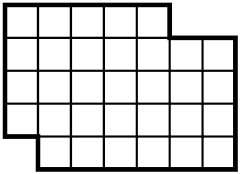Archive for the ‘Puzzles’ Category.
22nd November 2023, 12:04 pm
Here is another STEP homework question, which is a famous riddle.
Puzzle. Peter had ten cows. All but nine died. How many cows are left?
The wording is confusing on purpose. So, the students who are in a hurry subtract nine from ten and answer that only one cow is left. This answer is wrong. All but nine means that one cow died. So, the correct answer is nine.
One of my students decided that nine is the name of one of the cows, though it should have been capitalized. This means that all the cows except for Nine died, and only one cow, Nine, is left.
This student managed to find a legitimate explanation for the standard wrong answer.
Share:





10th November 2023, 12:46 pm
9th November 2023, 10:35 am
7th November 2023, 08:46 pm
A quine is a computer program which takes no input and produces a copy of its own source code as its only output.
Puzzle. Assuming English is a computer language, write a quine in English.
My students had many solutions on how to solve this puzzle. They were all variations on “Write this sentence.” This is a self-referential sentence which doesn’t quite work. I even tried it on ChatGPT with the following result, “Of course, I’d be happy to help! Please provide the sentence you’d like me to write, and I’ll assist you with it.”
However, the solution I originally had in mind worked. ChatGPT repeated my input. So, ChatGPT provides a simple way for you to check your answer to this puzzle.
My students had more ideas. One of them suggested screaming at a friend, forcing the friend person to scream back. In a similar vein, one might say hello to a person in order to hear hello back. I tried this with ChatGPT, but it didn’t work. The bot replied, “Hello! How can I assist you today?”
Another trivial idea is to write nothing. This certainly works perfectly with ChatGPT.
Share:





3rd November 2023, 12:28 pm
1st November 2023, 06:49 pm
13th October 2023, 04:42 pm
4th October 2023, 03:22 pm
13th September 2023, 12:29 pm
The Ural Math Battle in 2016 had several mafia-themed problems of various difficulty with the same initial setup.
Puzzle Setup. Among 100 residents of Saint-San, m are mafiosi, and the rest are civilians. A commissioner arrived to the town after getting this information. In an attempt to expose the mafia, this commissioner asked each of the residents to name s mafia suspects from among the other 99 residents. The commissioner knows that none of the mafiosi would name other mafiosi, but each civilian would name at least k mafia members. What is the maximum number of mafia members the commissioner can definitively identify after his survey?
- The most difficult case was m = s = 3 and k = 2.
- In the next case, where m = 3 and s = k = 2, the puzzle had a different task: prove that the commissioner can find at least one mafioso.
- In the third case, where m = s = 10 and k = 6, the question was whether the commissioner can find at least three mafiosi.
- In the fourth case, where m = s = 10 and k = 7, the question was whether the commissioner can find all the mafiosi.
- The last case was for younger students with m = 6, s = 10, and k = 6. The question was whether the commissioner can find all the mafiosi.
When I asked ChatGPT to translate the first and the most difficult case of this puzzle from Russian, ChatGPT decided to solve it too. At the end of its ridiculous solution, it concluded that the commissioner could identify all 21 mafiosi out of the given 3. So, if you comment on this blog that the answer to the first case is 21, I will know that you are a bot.
Share:





3rd September 2023, 04:57 pm
I recently saw another puzzle on Facebook, a generalization of a problem from the 2002 Belarus Olympiad. In the problem, there are red and white boxes. Given how Russia and Belarus are filled with propaganda, my first question was whether the Belarusian flag was red and white. But in fact, the official flag is red and green; however, the opposition uses a red and white one. It could either be a coincidence or a sneaky way of protesting. Anyway, here is the problem.
Puzzle. There are two boxes filled with candy. The red box has R candies, and the white box has W candies. Alice and Bob are playing a game where Alice starts, and both players have the same options each turn: Either move one candy from the red box to the white box or take two candies from any box and eat them. The player who can’t move loses. For which values of R and W is each of the following true?
- Alice, following her optimal strategy, wins but might lose if she makes a mistake.
- Alice wins no matter what.
- Bob, following his optimal strategy, wins but might lose if he makes a mistake.
- Bob wins no matter what.
The list of options is weird, but I decided to keep it to emphasize …. Oops, I do not want to spoil it. You can decide for yourself what I wanted to emphasize.
Share:





